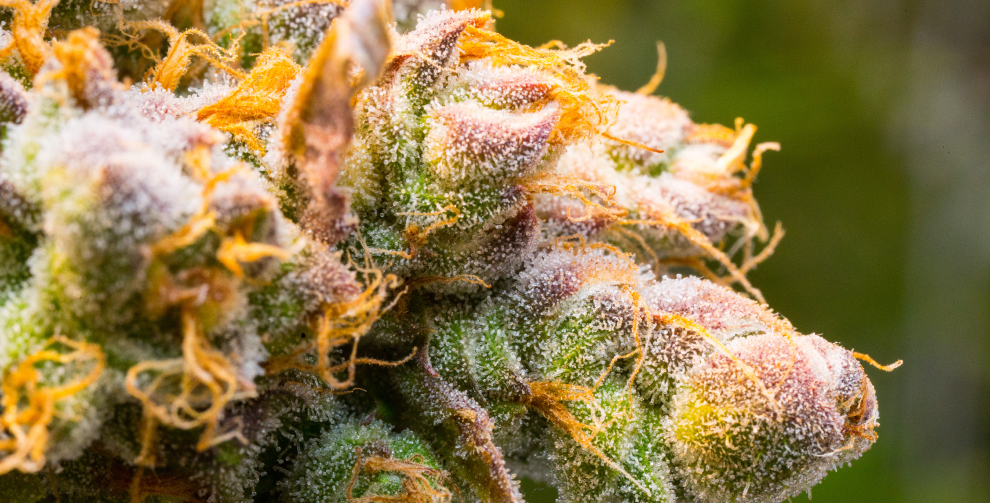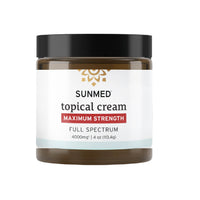Is Cherry Pie strain indica or sativa? Strain information
Understand the basics of the Cherry Pie strain, like whether it is indica or sativa.

Medically Reviewed by: Dr. Caley Scott, ND
The Cherry Pie strain of marijuana might sound like a tasty dessert, but this is a powerful and effective form of cannabis, through and through. Because strains have become easier to identify and isolate in recent years, this marks the perfect time to learn more about classics like Cherry Pie and what makes them unique.
One of the big questions we ask when examining any type of cannabis is how it’s classified, whether as an indica or sativa strain. This distinction, along with the origins of a cannabis strain and its unique effects, is key to learning more about your own cannabis tastes and how to find the best cannabinoid product for your needs.
In this article, let’s learn about the background of the legendary Cherry Pie strain, why it’s so beloved in the cannabis community, and the best way to incorporate this popular strain into your routine.
What are the different strains of cannabis?
Cannabis strains are generally sorted into three main categories: indica, sativa, and hybrid. While these are all derived from the same fundamental cannabis plant, changes in the environment and selective breeding processes have evolved through the years to create new and distinctive strains in each class.
Before we dive into the unique properties of Cherry Pie marijuana, let’s get some background on the main types of cannabis and set the stage for our discovery.
Indica strains
Cannabis indica strains are a category known for relaxing, mildly sedating effects. The plants tend to be relatively short, stocky, and resilient to harsher environmental factors compared to sativa strains. This is because the original cannabis indica strains originated in regions of Central Asia, including Afghanistan, Pakistan, and parts of India, with less humidity and arid climates.
For many people, the relaxing, “couch-lock” effects of indica are more suitable for soothing discomfort and minimizing the psychological side effects that come with other strains.
Sativa strains
Sativa strains are arguably the most popular types of cannabis in the world, thanks to their eye-catching physical properties and relatively high concentrations of THC. These strains are usually associated with an uplifting, cerebral experience, commonly called the “head high” that so many cannabis lovers enjoy.
There’s no doubt that sativa strains are visually impressive, growing much taller than indica strains and featuring longer, broader leaves. This is because sativa plants originated in more tropical climates like Southeast Asia, Central America, and parts of Africa.
However, the flowering buds of these sativa plants tend not to be as large or tightly packed due to the size of the stalks, stems, and leaves.
The best of both worlds: Hybrid strains
To access the best of both indica and sativa strains, hybrid strains are a go-to in the cannabis community. Growers have the process down to a science and can create the optimal ratio of both indica and sativa genetics, delivering unique products with distinctive effects.
Cherry Pie is an example of an indica-dominant hybrid strain, featuring slightly more indica genes as compared to sativa. This means the THC content is more manageable for cannabis newcomers and allows users to enjoy a blend of relaxation and mental stimulation.*
The role of hemp in the cannabis family
Hemp is an outlier in the cannabis family, but a member of the plant family nonetheless. It’s technically a cannabis sativa strain that is bred for very low levels of THC, specifically under 0.3% THC by dry weight.
We see hemp used for fiber products—think clothing, rope, and paper—and seed production for use in supplements rich in essential fatty acids and protein. Hemp is also used to make CBD products with minimal THC, with benefits like relaxation, reducing feelings of discomfort, and offering soothing sensations without the high.*
While THC levels are negligible in hemp products, don’t overlook the other use cases for this versatile plant in our economy and everyday life.
Is Cherry Pie strain indica or sativa?
Cherry Pie originated decades ago as a mix between its parent strains: Grandaddy Purple (GDP) and Durban Poison, also known as F1 Durban. While GDP is known as a classic sativa strain, Durban is a rather heavy indica strain used for cross-breeding to create inventive new cannabis types.
It’s unclear whether Cherry Pie was created intentionally or incidentally, but the makers of the strain struck gold by finding a balanced and enjoyable product like no other. Keep in mind that while Cherry Pie is indica-dominant, it still contains considerable sativa properties that provide uplifting effects.*
Although each version of Cherry Pie is slightly different, most are estimated to be about 60% indica and 40% sativa. Always remember to check the genetics analysis for your cannabis if available, and remember that breeders have different interpretations of popular strains like Cherry Pie.
What are the key cannabinoids and terpenes in Cherry Pie?
Cannabinoids are the unique chemical compounds found in the cannabis plant that interact with the endocannabinoid system (ECS).
Cherry Pie features a full range of rich cannabinoids that offer physical and psychological benefits, plus an enjoyable experience overall. Let’s see which cannabinoids are present and what to expect from Cherry Pie.
THC
Tetrahydrocannabinol is the main event in Cherry Pie, with a concentration of THC ranging between 15% and 25%. When smoked, THC molecules bind directly with the CB1 receptors of the endocannabinoid system, primarily in the brain.* This induces the high sensations of relaxation, stimulation, and mild euphoria that cannabis users seek.*
With moderate THC content in Cherry Pie and its hybrid strain nature, this makes it a fair bet for newcomers and veterans alike.*
CBD
Cannabidiol is also present in Cherry Pie, though smoking the flower of this plant likely won’t yield much CBD. If you want a CBD-rich experience, try looking for edibles derived from Cherry Pie which tend to include higher ratios of CBD for a more balanced, supplemental approach to cannabis.*
CBG
Cannabigerol (CBG) is known as an uplifting, non-psychoactive cannabinoid found in many types of cannabis. While Cherry Pie is not known for having particularly high CBG concentrations, popular edible products often emphasize CBG as a cognitive enhancer and energy booster.
What are the key terpenes in Cherry Pie?
As a versatile hybrid strain, Cherry Pie contains many of the terpenes you’d expect from a high-end type of cannabis. Let’s check out the most prevalent terpenes and see how they might impact your experience enjoying Cherry Pie.
Caryophyllene
Known for its peppery and spicy aroma, caryophyllene is a terpene associated with many cannabinoid compounds. It may help soothe physical discomfort in the body and even offer uplifting effects you might get from spices like pepper or cloves.
Pinene
Pinene is an abundant terpene found in pine trees, rosemary, sage, and many types of cannabis. It has an earthy aroma and “grounding” effects like mental clarity and stability, making it ideal for a strain like Cherry Pie.
Myrcene
The earthy and musky myrcene is found in hops, lemongrass, mangoes, and more. It has considerable relaxing effects and complements the “couch-lock” sensations you may get from using Cherry Pie and other indica-dominant cannabis strains.
Limonene
As the name suggests, we get a bright, tangy flavor from limonene, similar to lemons, limes, and other types of citrus. In the context of cannabis, these terpenes can enhance mood, reduce discomfort, and offer uplifting sensations.
How is the Cherry Pie strain grown?
Cherry Pie is a resilient strain thanks to its indica-dominant genetics but benefits from careful cultivation and planning like any other type of cannabis. It’s known for a compact and bushy phenotype, with dense and resinous buds featuring eye-catching trichomes.
The buds may feature colors like purple or maroon, and quality cultivations (such as Mediterranean climates) may yield distinctive orange pistils that contribute to their unique look.
The flowering time of Cherry Pie is anywhere from seven to nine weeks, making it about average compared to other strains of cannabis. However, growers are greeted with a distinctive sweet and tart aroma once the flowers emerge, living up to the Cherry Pie name.
What are the effects of Cherry Pie?
As an indica-centric strain, Cherry Pie provides a nice balance between uplifting and relaxing effects. Users will feel a sense of physical relaxation while still maintaining a sense of mental clarity and inspiration. This makes Cherry Pie a nice strain to enjoy with friends, explore nature, or even pursue creative projects.*
However, because it’s an indica-heavy strain, Cherry Pie might be better suited for use later in the day or in the evening. We suggest trying Cherry Pie when you’ve completed your most strenuous tasks for the day and have time to relax in full.*
You’ll love the unique sensory experience of Cherry Pie thanks to its bright flavor, smooth smoke, and characteristic “dank” qualities.
Are there any side effects to using Cherry Pie?
Users will find a mix of physical and cognitive effects from Cherry Pie, but are there any side effects to watch out for? Like any type of cannabis, some users will experience issues with dry mouth or dry eyes when using Cherry Pie, especially in higher amounts.
Be sure to keep your eye drops on hand and have a refreshing beverage to quench your thirst when enjoying Cherry Pie. You may also consider using CBD products to balance the effects of THC when smoking or consuming edibles.*
Additionally, it’s important to go into your cannabis experience knowing your own tolerance and experience level and always use trusted brands with transparent certificates of analysis for all their products.
How does Cherry Pie compare to other strains?
Cherry Pie is a unique strain with a slight indica emphasis, making it different from popular hybrids like Blue Dream or Kush. With Cherry Pie, you can enjoy a deeper sense of relaxation, while other strains might produce more mentally stimulating effects. The soothing effects of Cherry Pie truly make it a one-of-a-kind strain.
It’s all about knowing what you want from your cannabis experience and choosing the right strain for your needs at the proper time and place.
Final thoughts
As a balanced, indica-dominant hybrid, Cherry Pie is a great way to get a relaxed and mellow high. Whether your smoke the tart and sweet flower or opt for a more supplemental approach with our live resin gummies, you’re sure to enjoy your experience with Cherry Pie and its distinctive effects.*
*This statement has not been evaluated by the Food & Drug Administration. This product is not intended to diagnose, treat, cure, or prevent any disease."
Sources:
Cherry Pie strain (marijuana review) | The Cannabist
Cannabis Systematics at the Levels of Family, Genus, and Species | NIH
Weeding Out the Differences Between Indica and Sativa | Greatist
Cannabis sativa research trends, challenges, and new-age perspectives | PMC
Tetrahydrocannabinol (THC) - StatPearls | NCBI Bookshelf











